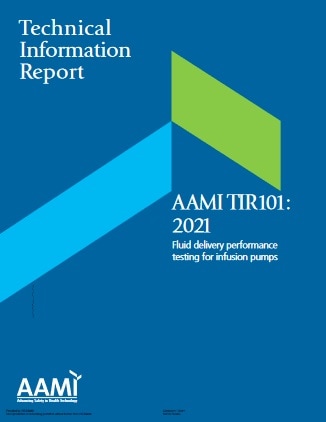AAMI規格 AAMI TIR101, 2021: Fluid delivery performance testing for infusion pumps, 輸液ポンプの輸液性能試験
Description
This document defines fluid delivery performance test methods that are intended to accurately and efficiently align with the intended use of an infusion pump in order to provide clinically relevant presentation of test results. This document is applicable to syringe pumps, container pumps, and volumetric infusion pumps for all indicated delivery modes including enteral, patient controlled analgesia (PCA), or epidural and prescribed infusate sources (e.g., volumetric infusion pump drawing from a syringe). This document does not establish criteria for the clinical acceptability of infusion pump performance, provide guidance for test method validation, or address uncertainty of measurement.
The tests included in this document are:
- start-up delay time;
- short and long-term flow-rate accuracy over the entire period of intended use;
- environmental and pressure effects on long-term flow-rate accuracy;
- bolus dose accuracy.
NOTE 1
This document is not meant to be all inclusive of performance testing, and methods therein, that might be relevant and/or necessary to establish the performance data that is specifically relevant to a particular infusion pump’s intended use and risk profile. Manufacturers should consider additional testing and/or scientific evidence if the infusion system is intended to deliver complex or non-Newtonian fluids.
NOTE 2
On-body delivery systems are not specifically addressed within this document; however, particular test methods within this report might be relevant to on-body delivery systems based on the intended use and risk profile of the system. Elements of the ISO 11608-1 [7] suite of standards might also be relevant for these types of delivery systems.
NOTE 3
Although the performance testing described in this document might be transferrable to implantable infusion pumps, this document is not intended to cover the testing necessary for implantable infusion pumps. See ISO 14708-4 [8] for information regarding implantable infusion pumps.
NOTE 4
It is the responsibility of the manufacturer to identify applicable environmental conditions. If there are additional environmental conditions that could impact product performance, those should be included in addition to the environmental conditions called out in Table 4. Respective standards including IEC 60601-1-11 [1] for the home healthcare environment and IEC 60601-1-12 [2] for medical emergency services should be considered as appropriate based on the labeling of the product. TIR101 test methods are generally limited in environments with mechanical vibration or shock by the test apparatus such as through the required precision of balances. If the environmental stressors are not compatible with the test methods defined in TIR101 (e.g., vibration is not compatible with use of balances), the manufacturer should identify alternative or additional test methods as appropriate such as including a subset of TIR test methods as pre- or post-tests if dictated by the intended use and/or risk management.
NOTE 5
The test methods of TIR101 characterize the delivery performance of the infusion pump at the time of test. It is the responsibility of the manufacturer to ensure appropriate characterization of the expected delivery performance over the use life of the infusion pump. This should include degradation of performance such as from wear out of the pumping mechanism. If performance degrades with depletion or aging of batteries, this should be considered, and a risk-based strategy should be adopted to inform clinicians to replace the battery. For batteries near their end of their manufacturer recommended service life, if flow rate accuracy is affected then an end of battery life alarm and/or near end of battery life alarm may be appropriate. If a battery with a low state of charge affects fluid delivery performance, then the manufacturer should establish the triggering points of their low battery alarms appropriately (e.g., low battery and battery depletion alarms). Manufacturers should include the flow rate accuracy testing and risk migration strategy for depleted or batteries near end of use life in their safety assurance case and disclose in operator’s manual if the deviation causes the performance to exceed the stated accuracy specification (e.g., greater than 5 %).
NOTE 6
The manufacturer should define a worst-case condition and perform the corresponding sub-set of testing on administration sets and disposables that are sterilized (if applicable) and aged to their indicated shelf-life. Manufacturers should include the justification for worst-case conditions in their safety assurance case and disclose in the operator’s manual if the deviation causes the performance to exceed the stated accuracy specification (e.g., greater than 5 %).











